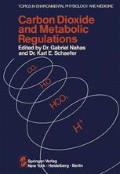Abstract
It is generally accepted on the basis of practical experience in submarines and other confined spaces that accumulation of CO2 in the inspired air amounting to a partial pressure of 15 mm Hg is subjectively acceptable—if even noticeable—and compatible with ordinary physical and mental activities. Nevertheless, measurable changes in ventilation and alveolar Pco2 have been reported by Lambertsen [1960] in resting subjects at 15 mm Hg Pco2 and in light exercise by Froeb [I960]. Schaefer and his associates [1963] have described alterations in respiration, acid-base, and electrolyte balance in the course of acclimatization and de-acclimatization to an environment with a \(\text{PI}_{\text{CO}_\text{2} } \) of 11 mm Hg. Relatively little factual information exists, however, on the effects of CO2 under conditions of strenuous exertion verging on the limits of work capacity as might be encountered in emergency situations in space operations, in submarines, or in diving activities. An excellent investigation by Menn, Sinclair, and Welch [1970] with inspired CO2 tensions ranging from 8 to 30 mm Hg revealed a consistent and proportionate increase in ventilation, but reduced CO2 output and respiratory exchange ratio (R.E.R.) in submaximal exercise. In exhausting exercise, with \(\text{PI}_{\text{CO}_\text{2} } \) 21 mm Hg ventilation was not significantly different from the controls, while maximal O2 intake was only slightly less. But there was a highly significant reduction in CO2 output. These authors concluded that strenuous exercise with exogenous hypercapnia leads to CO2 retention, adding respiratory acidosis to the metabolic one, thus forcing the respiratory system to its limits.
Access this chapter
Tax calculation will be finalised at checkout
Purchases are for personal use only
Preview
Unable to display preview. Download preview PDF.
Bibliography
Froeb, H. F., “Ventilatory response in SCUBA divers to carbon dioxide inhalation.” J. Appl Physiol 16:8 (1960).
Kaltreider, N. L., and Meneely, G. R., “The effect of exercise on the volume of blood.” Clin. Invest. 19:627–34 (1940).
Kosiek, J. P., and Klans, E. J., “Das Verhalten des Glukose, Laktat, Pyruvat und Cholesterin Spiegels im Serum nach erschöpfender Arbeit.” Med. Welt. 19:2154–60 (1968).
Lambertsen, C. J., “Carbon dioxide and respiration in acid-base homeostasis.” Anesthesiol. 21:642 (1960).
Laureil, H., and Pernow, B., “Effect of exercise on plasma potassium in man.” Acta Physiol Scand. 66:241–42 (1966).
Menn, S. J., Sinclair, R. D., and Welch, B. E., “Effects of inspired pCO2 up to 30 mg on responses of normal man to exercise.” J. Appl. Physiol 28:663–71 (1970).
Rahn, H., and Fenn, W. O., “A graphical analysis of the respiratory gas exchange.” The American Physiological Society, Washington, D.C. (1960) p. 40.
Schaefer, K. E., Hastings, B. J., Carey, C. R., and Nichols, G., Jr., “Respiratory acclimatization to carbon monoxide.” J. Appl Physiol 18:1071 (1963)
Staub, N. C., “Alveolar-arterial O2 tension gradient due to diffusion.” J. Appl. Physiol 18:673–80 (1963).
Whipp, B. J., and Wasserman, K., “Alveolararterial gas tension differences during graded exercise.” J. Appl. Physiol 27:361–65 (1969).
Author information
Authors and Affiliations
Editor information
Editors and Affiliations
Rights and permissions
Copyright information
© 1974 Springer-Verlag New York Inc.
About this paper
Cite this paper
Luft, U.C., Finkelstein, S., Elliott, J.C. (1974). Respiratory Gas Exchange, Acid-Base Balance, and Electrolytes during and after Maximal Work Breathing 15 mm Hg \(\text{PI}_{\text{CO}_\text{2} } \) . In: Nahas, G., Schaefer, K.E. (eds) Carbon Dioxide and Metabolic Regulations. Topics In Environmental Physiology And Medicine. Springer, New York, NY. https://doi.org/10.1007/978-1-4612-9831-1_27
Download citation
DOI: https://doi.org/10.1007/978-1-4612-9831-1_27
Publisher Name: Springer, New York, NY
Print ISBN: 978-1-4612-9833-5
Online ISBN: 978-1-4612-9831-1
eBook Packages: Springer Book Archive

